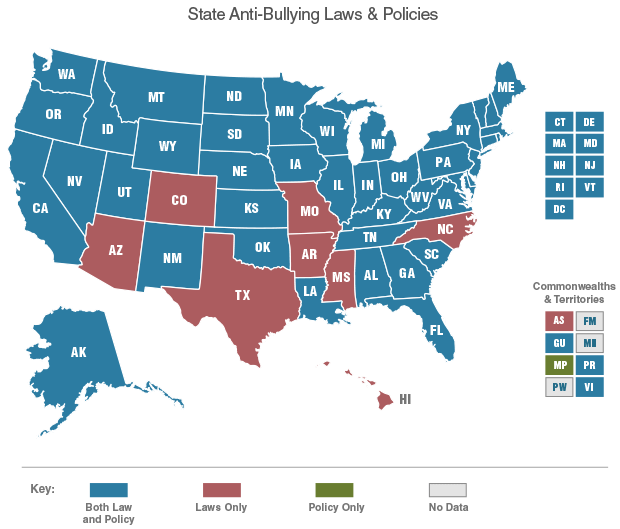State Laws
State and local lawmakers have taken action to prevent bullying and protect children 1. Each jurisdiction, including all 50 states, the District of Columbia and U.S. territories (state), addresses bullying differently. Some have established laws, policies, and regulations 2. Others have developed model policies schools and local educational agencies (districts) can use as they develop their own local laws, policies and regulations. Most state laws, policies, and regulations require districts and schools to implement a bullying policy and procedures to investigate and respond to bullying when it occurs. A handful of states also require bullying prevention programs, inclusion of bullying prevention in health education standards, and/or teacher professional development. These state laws generally do not prescribe specific consequences for kids who engage in bullying behavior. Further, states may address bullying, cyberbullying, and related behaviors in a single law or across multiple laws. In some cases, bullying appears in the criminal code of a state that may apply to juveniles.
Common Components in State Laws and Regulations
In December 2010, the U.S. Department of Education developed a framework of common components found in state laws, policies, and regulations focused on bullying at the time. The framework was used to describe how schools were taking action to prevent and respond to bullying incidents. The common components found in state laws, policies, and regulations– which have evolved over time--include definitions of bullying, defining characteristics that are commonly targeted for bullying behaviors, and detailed requirements for school district policies.
Common Components of State Anti-Bullying Laws and Regulations show the components in each state’s laws, policies, and regulations, allowing for a quick comparison across states. Click on a state or territory below to find out more about their anti-bullying laws and policies and which of the key components they contain.
State Anti-Bullying Laws & Policies
For more information about the anti-bullying laws and policies of specific states or territories, select a state on the map.

- Alabama(Both Law and Policy)
- Alaska(Both Law and Policy)
- American Samoa(Laws Only)
- Arizona(Laws Only)
- Arkansas(Laws Only)
- California(Both Law and Policy)
- Colorado(Laws Only)
- Connecticut(Both Law and Policy)
- Delaware(Both Law and Policy)
- District of Columbia(Both Law and Policy)
- Florida(Both Law and Policy)
- Georgia(Both Law and Policy)
- Guam(Both Law and Policy)
- Hawaii(Laws Only)
- Idaho(Both Law and Policy)
- Illinois(Both Law and Policy)
- Indiana(Both Law and Policy)
- Iowa(Both Law and Policy)
- Kansas(Both Law and Policy)
- Kentucky(Both Law and Policy)
- Louisiana(Both Law and Policy)
- Maine(Both Law and Policy)
- Maryland(Both Law and Policy)
- Massachusetts(Both Law and Policy)
- Michigan(Both Law and Policy)
- Minnesota(Both Law and Policy)
- Mississippi(Laws Only)
- Missouri(Laws Only)
- Montana(Both Law and Policy)
- Nebraska(Both Law and Policy)
- Nevada(Both Law and Policy)
- New Hampshire(Both Law and Policy)
- New Jersey(Both Law and Policy)
- New Mexico(Both Law and Policy)
- New York(Both Law and Policy)
- North Carolina(Laws Only)
- North Dakota(Both Law and Policy)
- Northern Mariana Islands(Policy Only)
- Ohio(Both Law and Policy)
- Oklahoma(Both Law and Policy)
- Oregon(Both Law and Policy)
- Pennsylvania(Both Law and Policy)
- Puerto Rico(Both Law and Policy)
- Rhode Island(Both Law and Policy)
- South Carolina(Both Law and Policy)
- South Dakota(Both Law and Policy)
- Tennessee(Both Law and Policy)
- Texas(Laws Only)
- U.S. Virgin Islands(Both Law and Policy)
- Utah(Both Law and Policy)
- Vermont(Both Law and Policy)
- Virginia(Both Law and Policy)
- Washington(Both Law and Policy)
- West Virginia(Both Law and Policy)
- Wisconsin(Both Law and Policy)
- Wyoming(Both Law and Policy)
Federal Law
There is no federal law that specifically applies to bullying. In some cases, when bullying is based on race or ethnicity, color, national origin, sex, disability, or religion, bullying overlaps with harassment and schools are legally obligated to address it. Read more about when bullying overlaps with harassment and how to report it to the U.S. Department of Education’s Office for Civil Rights and U.S. Department of Justice's Civil Rights Division.
Endnotes
1 There is no federal law that specifically applies to bullying. In some cases, when bullying is based on race or ethnicity, color, national origin, sex, disability, or religion*, bullying overlaps with harassment and schools are legally obligated to address it. Read more about when bullying overlaps with harassment and how to report it to the U.S. Department of Education’s Office for Civil Rights and U.S. Department of Justice's Civil Rights Division. See also Federal Laws.
2 To better understand the distinction between law, policies and regulations, go to http://www.publichealthlawcenter.org/sites/default/files/resources/tclc-fs-laws-policies-regs-commonterms-2015.pdf

